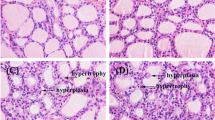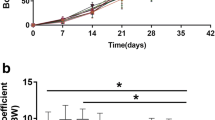Abstract
Polychlorinated biphenyls (PCBs) and DDT are widespread environmental persistent organic pollutants that have various adverse effects on reproduction, development and endocrine function. In order to elucidate effects of PCBs and DDT on thyroid hormone homeostasis, Sprague–Dawley rats were dosed with PCB153 and p,p′-DDE intraperitoneally (ip) for five consecutive days and sacrificed within 24 h after the last dose. Results indicated that after combined exposure to PCB153 and p,p′-DDE, total thyroxine , free thyroxine, total triiodothyronine, and thyroid-stimulating hormone in serum were decreased, whereas free triiodothyronine and thyrotropin-releasing hormone were not affected. Thyroglobulin and transthyretin levels in serum were significantly reduced. mRNA expression of deiodinases 2 (D2) was also suppressed, while D1 and D3 levels were not significantly influenced after combined exposure. PCB153 and p,p′-DDE induced hepatic enzymes, UDPGTs, CYP1A1, CYP2B1, and CYP3A1 mRNA expressions being significantly elevated. Moreover, TRα1, TRβ1, and TRHr expressions in the hypothalamus displayed increasing trends after combined exposure to PCB153 and p,p′-DDE. Taken together, observed results indicate that PCB153 and p,p′-DDE could disorder thyroid hormone homeostasis via thyroglobulin, deiodinase 2, transthyretin, hepatic enzymes, and hormone receptors.







Similar content being viewed by others
References
Abel ED, Boers ME, Pazos-Moura C, Moura E, Kaulbach H, Zakaria M, Lowell B, Radovick S, Liberman MC, Wondisford F (1999) Divergent roles for thyroid hormone receptor beta isoforms in the endocrine axis and auditory system. J Clin Invest 104:291–300
Cao J, Lin Y, Guo LH, Zhang AQ, Wei Y, Yang Y (2010) Structure-based investigation on the binding interaction of hydroxylated polybrominated diphenyl ethers with thyroxine transport proteins. Toxicology 277:20–28
CDC (2003) Second National Report on Human Exposure to Environmental Chemicals. Centers for Disease Control and Prevention. Washington, DC
Chauhan KR, Kodavanti PR, McKinney JD (2000) Assessing the role of ortho-substitution on polychlorinated biphenyl binding to transthyretin, a thyroxine transport protein. Toxicol Appl Pharmacol 162:10–21
Cheek AO, Kow K, Chen J, McLachlan JA (1999) Potential mechanisms of thyroid disruption in humans: interaction of organochlorine compounds with thyroid receptor, transthyretin, and thyroid-binding globulin. Environ Health Perspect 107:273–278
Craft ES, DeVito MJ, Crofton KM (2002) Comparative responsiveness of hypothyroxinemia and hepatic enzyme induction in Long-Evans rats versus C57BL/6 J mice exposed to TCDD-like and phenobarbital-like polychlorinated biphenyl congeners. Toxicol Sci 68:372–380
Diamanti-Kandarakis E, Palioura E, Kandarakis SA, Koutsilieris M (2010) The impact of endocrine disruptors on endocrine targets. Horm Metab Res 42:543–552
Dunn JT, Dunn AD (1999) The importance of thyroglobulin structure for thyroid hormone biosynthesis. Biochimie 81:505–509
Ganem LG, Trottier E, Anderson A, Jefcoate CR (1999) Phenobarbital induction of CYP2B1/2 in primary hepatocytes: endocrine regulation and evidence for a single pathway for multiple inducers. Toxicol Appl Pharmacol 155:32–42
Gereben B, Zeöld A, Dentice M, Salvatore D, Bianco AC (2008) Activation and inactivation of thyroid hormone by deiodinases: local action with general consequences. Cell Mol Life Sci 65:570–590
Gould JC, Cooper KR, Scanes CG (1999) Effects of polychlorinated biphenyls on thyroid hormones and liver type I monodeiodinase in the chick embryo. Ecotoxicol Environ Saf 43:195–203
Hallgren S, Darnerud PO (2002) Polybrominated diphenyl ethers (PBDEs), polychlorinated biphenyls (PCBs) and chlorinated paraffins (CPs) in rats-testing interactions and mechanisms for thyroid hormone effects. Toxicology 177:227–243
Hansen LG (1998) Stepping backward to improve assessment of PCB congener toxicities. Environ Health Perspect 106:171–189
Hedge JM, DeVito MJ, Crofton KM (2009) In vivo acute exposure to polychlorinated biphenyls: effects on free and total thyroxine in rats. Int J Toxicol 28:382–391
Hood A, Allen ML, Liu Y, Liu J, Klaassen CD (2003) Induction of T(4) UDP-GT activity, serum thyroid stimulating hormone, and thyroid follicular cell proliferation in mice treated with microsomal enzyme inducers. Toxicol Appl Pharmacol 188:6–13
Ibhazehiebo K, Iwasaki T, Kimura-Kuroda J, Miyazaki W, Shimokawa N, Koibuchi N (2011) Disruption of thyroid hormone receptor-mediated transcription and thyroid hormone-induced Purkinje cell dendrite arborization by polybrominated diphenyl ethers. Environ Health Perspect 119:168–175
Khan MA, Hansen LG (2003) Ortho-substituted polychlorinated biphenyl (PCB) congeners (95 or 101) decrease pituitary response to thyrotropin releasing hormone. Toxicol Lett 144:173–182
Khan MA, Lichtensteiger CA, Faroon O, Mumtaz M, Schaeffer DJ, Hansen LG (2002) The hypothalamo-pituitary-thyroid (HPT) axis: a target of nonpersistent ortho-substituted PCB congeners. Toxicol Sci 65:52–61
Kopec AK, Burgoon LD, Ibrahim-Aibo D, Mets BD, Tashiro C, Potter D, Sharratt B, Harkema JR, Zacharewski TR (2010) PCB153-elicited hepatic responses in the immature, ovariectomized C57BL/6 mice: comparative toxicogenomic effects of dioxin and non-dioxin-like ligands. Toxicol Appl Pharmacol 243:359–371
Kopp P (2005) Thyroid hormone synthesis: thyroid iodine metabolism. In: Braverman L, Utiger R (eds) Werner and Ingbar’s the thyroid: a fundamental and clinical text, 9th edn. Lippincott Williams Wilkins, New York, pp 52–76
Lewis DF, Lake BG, George SG, Dickins M, Eddershaw PJ, Tarbit MH, Beresford AP, Goldfarb PS, Guengerich FP (1999) Molecular modelling of CYP1 family enzymes CYP1A1, CYP1A2, CYP1A6 and CYP1B1 based on sequence homology with CYP102. Toxicology 139:53–79
Lin JD (2008) Thyroglobulin and human thyroid cancer. Clin Chim Acta 388:15–21
Liu C, Ha M, Cui Y, Wang C, Yan M, Fu W, Quan C, Zhou J, Yang K (2012a) JNK pathway decreases thyroid hormones via TRH receptor: a novel mechanism for disturbance of thyroid hormone homeostasis by PCB153. Toxicology 302:68–76
Liu C, Shi Y, Li H, Wang Y, Yang K (2011) p, p′-DDE disturbs the homeostasis of thyroid hormones via thyroid hormone receptors, transthyretin, and hepatic enzymes. Horm Metab Res 43:391–396
Liu C, Wang Y, Quan C, Yan M, Zhou J, Wang C, Yang K (2012b) Raf-1 is dually down regulated by p, p′-DDE via reduced thyroid hormone and activated ERK. Pestic Biochem Phys 103:68–73
Meerts IA (2001) In vitro and in vivo interactions of organohalogens with the endocrine system-the role of metabolites and implications for human health. Thesis. Department of Toxicology, Wageningen University, Wageningen, the Netherlands (ISBN 90-5808-522-8)
Schell LM, Gallo MV, Denham M, Ravenscroft J, DeCaprio AP, Carpenter DO (2008) Relationship of thyroid hormone levels to levels of polychlorinated biphenyls, lead, p, p′-DDE, and other toxicants in Akwesasne Mohawk youth. Environ Health Perspect 116:806–813
Schuur AG, Legger FF, van Meeteren ME, Moonen MJ, van Leeuwen-Bol I, Bergman A, Visser TJ, Brouwer A (1998) In vitro inhibition of thyroid hormone sulfation by hydroxylated metabolites of halogenated aromatic hydrocarbons. Chem Res Toxicol 11:1075–1081
Van den Berg KJ, van Raaij JA, Bragt PC, Notten WR (1991) Interactions of halogenated industrial chemicals with transthyretin and effects on thyroid hormone levels in vivo. Arch Toxicol 65:15–19
Webb CM, McNabb FM (2008) Polychlorinated biphenyl effects on avian hepatic enzyme induction and thyroid function. Gen Comp Endocrinol 155:650–657
Zhou T, Ross DG, DeVito MJ, Crofton KM (2001) Effects of short-term in vivo exposure to polybrominated diphenyl ethers on thyroid hormones and hepatic enzyme activities in weanling rats. Toxicol Sci 61:76–82
Acknowledgments
This work is supported by grants from the National Natural Science Foundation of China (81172623).
Conflict of interest
No conflict of interest.
Author information
Authors and Affiliations
Corresponding author
Additional information
Responsible editor: Philippe Garrigues
Rights and permissions
About this article
Cite this article
Liu, C., Ha, M., Li, L. et al. PCB153 and p,p′-DDE disorder thyroid hormones via thyroglobulin, deiodinase 2, transthyretin, hepatic enzymes and receptors. Environ Sci Pollut Res 21, 11361–11369 (2014). https://doi.org/10.1007/s11356-014-3093-3
Received:
Accepted:
Published:
Issue Date:
DOI: https://doi.org/10.1007/s11356-014-3093-3




